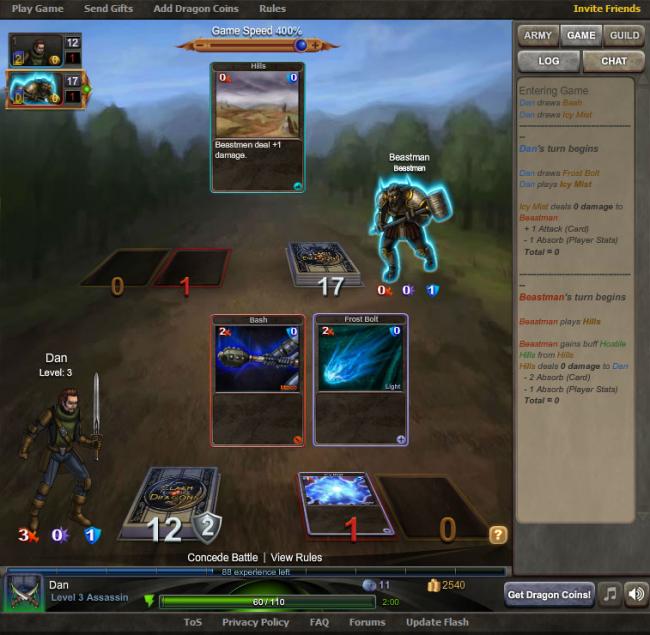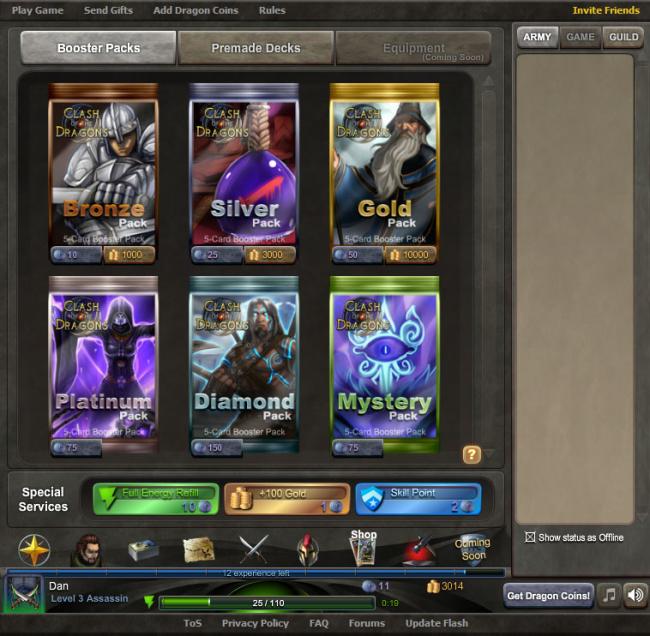- Wondering how to get Monopoly GO! free rolls? Well, you’ve come to the right place. In this guide, we provide you with a bunch of tips and tricks to get some free rolls for the hit new mobile game. We’ll …
Best Roblox Horror Games to Play Right Now – Updated Weekly
By Adele Wilson
Our Best Roblox Horror Games guide features the scariest and most creative experiences to play right now on the platform!The BEST Roblox Games of The Week – Games You Need To Play!
By Sho Roberts
Our feature shares our pick for the Best Roblox Games of the week! With our feature, we guarantee you'll find something new to play!Type Soul Clan Rarity Guide – All Legendary And Common Clans Listed!
By Nathan Ball
Wondering what your odds of rolling a particular Clan are? Wonder no more, with my handy Type Soul Clan Rarity guide.
Clash of the Dragons Review
I fancy myself a serious “casual” player of collectible card games (CCGs). I’m quite fond of Magic: The Gathering and went all gaga when Shadow Era came to my PC, iPod, and iPad. But until now I’ve never played a CCG on Facebook, so I really didn’t know what to expect out of Clash of the Dragons. But a unique damage system hooked me in pretty quickly.

A unique damage system helps make Clash of the Dragons feel different
I fancy myself a serious “casual” player of collectible card games (CCGs). I’m quite fond of Magic: The Gathering and went all gaga when Shadow Era came to my PC, iPod, and iPad. But until now I’ve never played a CCG on Facebook, so I really didn’t know what to expect out of Clash of the Dragons. But a unique damage system hooked me in pretty quickly.
Each CCG seems to have it’s own variation on the theme of using a deck to represent battle. In Magic you play mana cards that represent your summoning power for other cards. In Shadow Era, you discard cards to give you power to summon others. In Clash of the Dragons you don’t need power to play cards, you can do that anytime. But when you take damage, you discard cards equal to that damage…so in essence your hitpoints are the number of cards in your deck. And when you’re out of cards you’re dead.
The cards are set-up pretty simply, and are separated into attacks, buffs, and heals for the most part. Some cards also have a defensive bonus attached to them. The defense score acts as a shield to absorb damage before you have to discard cards, so if your opponent does three damage and you have a two defense then you only lose one card. The heals return cards from your graveyard and shuffle them back into your deck.

Each card lists its offensive and defensive power at the top, and any effects at the bottom. So a buff card will have an attack score (the number of cards your opponent will discard) as well as text explaining what else happens (bonus to damage on next attack for instance).
The attacks score listed on the card isn’t solely the amount of damage done, however. Your character has a class that confers different bonuses. Then there’s always a chance that a card played will be a critical hit, adding even more cards to the discard pile.
So naturally you’ll want to tailor your deck to not only your playing style but to your class; there’s not much sense in having a heavy magic deck if you’re playing as an assassin. Adding new cards to your deck, and managing multiple decks, is where the money comes in.
You’ll spend both in-game and real world cash on packs of booster cards to make you deck more powerful against both the game and in PvP (player vs. player). Thus no two decks will ever be the same and in theory spending more money will lead to a better deck. Those looking for a one time expense that puts everyone on equal footing might find a few deal breakers with Clash of the Dragons, or any CCG for that matter.

You’ll gain experience for each fight you win and will level up occasionally scoring upgrade points and in-game money to spend. You can upgrade the amount of cards that can be in your deck and give yourself the ability to have multiple decks or duplicate cards in a deck.
The game has a nice overworld system that you use to travel around and challenge bad guys to card duels, and you can always back out of the map to craft items, buy and organize cards, or ] even switch classes.
Unfortunately, the game is quite lacking visually. The card art is uninspired and amateurish looking and the animation is barely evident. It makes the game look cheaper than the gameplay is, and I fear that some would pass it by just because of how it looks. I’d love to see some better art assets make their way into the game.
As a CCG I really enjoyed the different take on the hit point system that Clash of the Dragons uses. The idea that I’m not only losing life but cards as well makes for interesting choices, as I’m less inclined to let my guard down. It’s an interesting balance, and feels unique, which is quite an accomplishment in the overcrowded CCG space.

The good

The bad
More articles...
Monopoly GO! Free Rolls – Links For Free Dice
By Glen Fox
Wondering how to get Monopoly GO! free rolls? Well, you’ve come to the right place. In this guide, we provide you with a bunch of tips and tricks to get some free rolls for the hit new mobile game. We’ll …Best Roblox Horror Games to Play Right Now – Updated Weekly
By Adele Wilson
Our Best Roblox Horror Games guide features the scariest and most creative experiences to play right now on the platform!The BEST Roblox Games of The Week – Games You Need To Play!
By Sho Roberts
Our feature shares our pick for the Best Roblox Games of the week! With our feature, we guarantee you'll find something new to play!Type Soul Clan Rarity Guide – All Legendary And Common Clans Listed!
By Nathan Ball
Wondering what your odds of rolling a particular Clan are? Wonder no more, with my handy Type Soul Clan Rarity guide.







